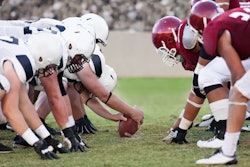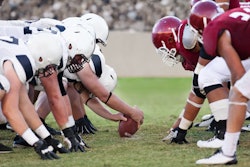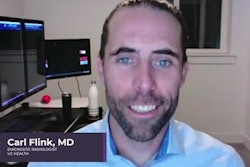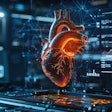Football, basketball, and hockey oh my! Sports radiologists are preparing for another fall season of high-contact sports, and that means brushing up on protocols and emphasizing teamwork among one's clinician colleagues.
But getting ready for an uptick in musculoskeletal imaging doesn’t have to be daunting, according to Tim Klostermeier, MD, from UC Health in Cincinnati, OH.
“I love the role I play in diagnosing and treating these athletes. I do want to stress the team approach,” Kolstermeier told AuntMinnie.com. “There’s a lot of things from the injury to them being treated urgently, from getting them in a scanner and diagnosing them to taking them to the treatment phase.”
Klostermeier began his health journey in 1989, attending medical school at the University of Cincinnati. Prior to that, he studied architecture. He received his certification for diagnostic radiology from the American Board of Radiology in 1997, specializing in musculoskeletal imaging.
“It [radiology] was a good fit for me because it’s kind of the architecture of the body. I ended up combining both things,” Klostermeier said. “I’ve always loved the musculoskeletal side of radiology and working with the athletes and teams.”
Cincinnati is home to several athletic teams on the major and minor league levels, as well as collegiate teams. These include the NFL’s Bengals, the University of Cincinnati Bearcats athletics, and the MLB’s Reds, among others. UC Health was put in the spotlight in early 2023 after Buffalo Bills player Damar Hamlin experienced cardiac arrest following a hard on-field collision in a game against the Bengals. Hamlin was treated at the hospital and made a full recovery.
In a previous interview with AuntMinnie.com, Carl Flink, MD, from UC Health said that the clinicians are trained for mass casualty events and have conversations about preparations.
“I don’t want to minimize things, but a patient, no matter how high the profile or how complex the trauma is, that’s something we’re always prepared to handle,” said Flink, who was part of the Hamlin care team.
Klostermeier also said the team was well prepared for the Hamlin care experience. Being at a level one trauma center, Klostermeier and colleagues have the capacity for busier workloads and care for severe injuries. However, Klostermeier added that the team is always looking at new ways to image and make protocols more efficient.
“It’s a 24/7 operation. We have the ability to scan at any time and the shifts are there,” he said. “That’s a real advantage, especially when you have games at night and away games.”
He added that along with higher imaging volumes for fall and winter sports, there is an increase in the severity of injuries, including those of the head and spine. Previous imaging studies have found how injuries and repeated exposure to head impact affect brain regions in football players.
“These are things you just don’t see when you’re lifting weights and running,” Klostermeier said.
For Klostermeier, the keys to success in sports imaging as imaging volumes increase include checking in frequently with referring clinicians and offering imaging services for sporting events, as well as taking team approaches toward imaging and treatment.
“We want to get these kids back playing as soon as possible. So, you want to have it in place where you can image them maybe Saturday morning or have a clinic Saturday afternoon,” he said. “That’s about access and I think it’s good to check in with your team.”



















